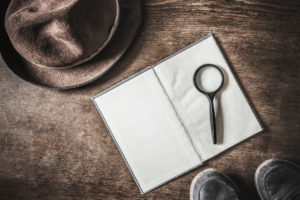How to Use Foreshadowing
Foreshadowing- a concept just as elusive and mysterious as its name. Though it may sound like a realm from a fantasy video game, the actual definition is “a literary device that gives a warning or indicator of a future event.” This is the device that gives readers that, “aha!” moment during a reveal. By planting small pieces of information throughout your book leading up to a big reveal, the reader will then be able to go back later and see all the clues they’ve missed. It also shows readers that you, the writer, did masterful work in terms of outlining and planning out the novel. But how do you give the readers a clue without being so obvious that the reveal is thrown away?

The Plant
The first part of foreshadowing is ‘the plant’ or putting in the relevant information in a subtle way. Foreshadowing is a balancing act; the information needs to be sprinkled throughout the novel, but not in such an obvious way that it tips the reader off about your ending. One great example of an author who is a master of foreshadowing is J.K. Rowling, author of the Harry Potter series. There are countless examples to choose from, but one is (spoiler alert) about finding Ravenclaw’s diadem (crown). Though this item doesn’t become significant until book seven, back in book six Rowling makes a brief mention of the item when Harry is in the Room of Requirement. He simply notes seeing a crown among other miscellaneous items in this room. This wasn’t an obvious detail at the time of ‘the plant,’ but knowing the author was already planning out its significance a book ahead of time is a fantastic payoff.
There are other ways to create a plant outside the world of fantasy. For example, your protagonist can notice a coworker looking for jobs online, foreshadowing a violent act at work. Your detective protagonist could be investigating a house and a drawer got stuck while they were trying to open it- maybe because it has a secret compartment hiding a gun that is later found. Though it’s cliche, it could be as simple as a protagonist’s close friend telling them, “Be careful who you trust.” The plant must be something small that will later pertain to the climax or resolution of the novel. This involves planning, outlining, and technique. If the plant occurs toward the beginning of your book, make sure you remind your readers of it either throughout the book or at the payoff.

The Distractions
In order to prevent your foreshadowing from being obvious, make sure you’re creating other suspicious circumstances and threads that your protagonist will follow. No matter how subtle you think you’re being with your plant, astute readers will likely pick up on it. This is why you need to create other plot points for them to follow. This way, their suspicions will likely be swayed or they may forget about the small detail entirely- until the inevitable reveal. When ‘the payoff’ finally occurs, you want to create this sense of, “Aha! Of course, it had to be [insert circumstance]!” You want the payoff to make sense to the readers, but still be unpredictable. So they should have that ‘aha’ moment, even though the story could’ve very easily could’ve ended in several different resolutions equally plausible.

The Payoff
This is the final part of masterful foreshadowing. If you’ve done your job correctly with ‘the plant’, all you’ll really need to do here is let the scene unfold and let the action play out as you’ve planned. This will be an ‘aha’ moment for your readers, so don’t be afraid to create the drama. Just remember to explain all of the plot points you used throughout the story. So don’t just explain the ‘payoff’- make sure the distractions are explained as well (whether that be in your climax or resolution).
Are you ready to publish your book? Contact us today!
